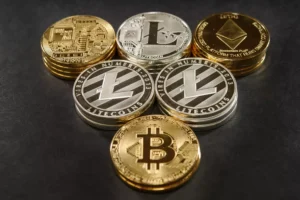We love a good blockchain: a distributed, decentralized, digital technology designed to give back control to the people. But while a lot is happening with blockchains as we know them, there are still kinks that need to be ironed out. One of the biggest is that many blockchains we know and love are stand-alone ecosystems that cannot work with other networks. It’s a compatibility issue. But this problem can also be solved. Let’s discuss what is a blockchain bridge.
The definition of a blockchain bridge
Blockchain bridges create connections between two ecosystems. Just like a physical bridge connects two physical locations, they connect two different worlds of blockchains running on similar or other protocols. Such connection allows the transfer of data and tokens between ecosystems. Bridges help extend «distributed ledgers» beyond the local boundaries of the mesh network, building invisible interconnections.
All blockchains are developed in insulated environments with various rules and consensus algorithms within each network. Therefore, two blockchains cannot interact natively, meaning that tokens and assets cannot move freely from one blockchain to another. Bridges come into the equation because they are the middleware between several ecosystems.
If you own bitcoins but want to participate in DeFi activities on the Ethereum network, the bridge will let you do so without selling your bitcoins.


Turnkey Brokerage Solution For Your Business
Get the most profitable fully licensed fx/crypto brokerage software or ready-to-operate business in 48 hours. Best-in-class web & mobile trading platforms, sales-driven CRM, full integration with MT4/5, and 150+ payment providers.
How does a blockchain bridge work?
A bridge involves multiple steps to transfer information (assets, contract calls, proofs, state) from a source blockchain to the desired blockchain.
- Monitoring: an agent known as an oracle, validator, or relay monitors the state of the original blockchain.
- Message relaying: when an entity detects an event occurring in the blockchain, it initiates the transfer of information from the source blockchain to the target blockchain.
- Consensus: in some cases, monitoring participants must reach an agreement to be able to communicate information to the target blockchain.
- Signing: actors or agents cryptographically sign information sent to another blockchain.
Bridges rely on the Burn-and-Mint protocol. Tokens are not transferred but are burned (destroyed) in the source blockchain and minted (created) in the target blockchain.

Types of blockchain bridges
There are several options for bridges. Following are the different types of bridges that currently exist. Each of them has its area of use, advantages, and limitations.
By way of decision-making
One common category is to divide bridges into two types: custodial vs. non-custodial bridges. Custodial bridges require users to trust a central entity for the correct and secure operation of the system. Users should do extensive research to make sure this property is trustworthy.
Non-custodial bridges act in a decentralized manner, relying on smart contracts to manage the locking and minting of cryptocurrencies, eliminating the need to trust the bridge operator. In this case, the system’s security is only as good as the underlying code.
By function
Let’s consider the classification of blockchain bridges by function. Some examples include wrapped asset bridges and side chain bridges.
Wrapped asset bridges enable crypto interoperability, such as transferring bitcoins to the Ethereum network by transferring BTC to Wrapped BTC (WBTC), an ERC20 token compatible with the Ethereum network. Sidechain bridges connect a parent blockchain to its child sidechain, enabling communication between them. They are necessary because the parent and sidechain may have different consensus mechanisms.
By a mechanism
Blockchain bridges by mechanism are divided into (unidirectional) and two-way (bidirectional). A one-way bridge means users can only connect assets to one target blockchain but not back to its blockchain. Bidirectional bridges allow assets to be connected in both directions.
Advantages and disadvantages of blockchain bridges
When we learn what is a blockchain bridge, it’s time to understand its purpose. Bridges are essential because they allow users to move and use their digital assets more efficiently and scale them to support growth and change. The best bridges provide many benefits, including:
- Eliminate development issues and reduce transmission costs: developers building applications for a particular platform often face the challenges of slower transactions between two ecosystems and higher prices during high demand and congestion. Using bridges, developers can easily send tokens to the blockchain, which processes them faster and at a lower cost. Bridges allow developers to continue building applications on their preferred platforms without incurring interoperability issues or routing costs.
- Excellent scalability across different networks: both ecosystems benefit from utilizing a bridge. First, the bridge reduces network traffic by distributing token processing across other, less busy networks. In addition, the bridge makes blockchains infinitely scalable by removing consensus and various ecosystem-specific rules.
- Faster, almost instantaneous payments and settlements: bridges solve the scalability issues often faced by popular networks like Ethereum, enabling instantaneous peer-to-peer transactions. Payments and settlements do not depend on network congestion or traffic. Instead, workloads are transferred to less busy blockchains for instant processing. DApps are the biggest beneficiaries of bridges, executing complex transactions with fewer hops and faster speeds.
It would help if you remembered that bridges have some limitations. Attackers took advantage of smart contract vulnerabilities in some bridges. Attackers from the bridges have misappropriated vast amounts of cryptography.
Some examples of bridges
For Bitcoin, the most well-known cryptocurrency, the most common option is to use Wrapped Bitcoin (WBTC). Wrapped Bitcoin is often referred to as a bridge because it allows bitcoin to be used as an ERC-20 token, a token specification that is supported by many other blockchains.
When choosing a cross-chain bridge, users need to be sure the specific network, as well as the token or NFT they want to use, is supported. Different networks also have additional fees, which can be volatile and change quickly.
Here are some famous cross-chain bridges:
- Binance Bridge has many options for connecting to the growing list of cryptocurrencies. The project is related to the Binance Smart Chain blockchain project, renamed BNB Chain in February 2022. However, Binance Bridge is not limited to this single blockchain. Supported networks: Ethereum, Solana, BNB Chain, Tron, and more.
- Сross-Chain bridge: such a platform was developed by the German-based organization Tixl, which was renamed the Autobahn Network in March 2022. Cross-Chain Bridge supports the connection of tokens and NFTs between multiple networks. Supported networks: Avalanche, Ethereum, Polygon, etc.
- Multichain: formerly known as Fantom Anyswap, Multichain bills itself as a cross-chain router protocol enabling the flow of information and assets across different networks. No other bridge service supports as many types of tokens as Multichain, including Arbitrum, KCC, Litecoin, Metis, etc.
The development of the blockchain market is driven by constant innovation. There are pioneering protocols such as the Bitcoin and Ethereum networks, followed by many alternative layer 1 and 2 blockchains. The amount of crypto coins and tokens has grown exponentially.
Having separate rules and technologies, they need bridges to be interconnected. Therefore, it is essential to understand what is a blockchain bridge. The bridged ecosystem is more cohesive and interoperable, opening up opportunities for better scalability and efficiency. The search for a safer and more reliable design continues with multiple attacks on cross-chain bridges.






